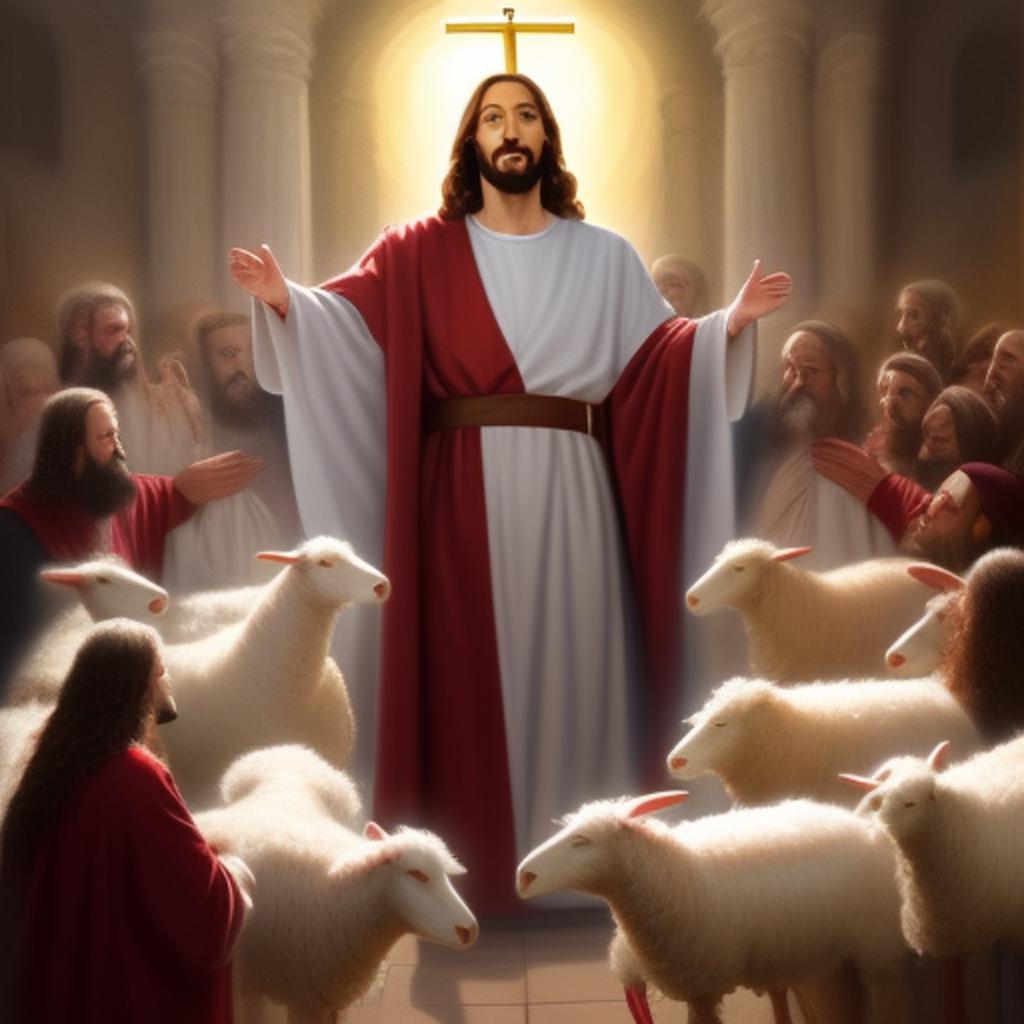Introduction: Understanding the Significance of Leviticus 6 and its Connection to Jesus and Messianic Prophecies
Leviticus 6 holds immense theological significance as it provides insights into the guilt offering and its connection to Jesus and Messianic prophecies in the Old Testament. By studying Leviticus 6 in the context of Old Testament prophecies and the fulfillment of God’s plan of salvation, we can gain a profound understanding of biblical theology and the significance of Jesus’ role as the Messiah.
The guilt offering described in Leviticus 6 is a crucial aspect of the sacrificial system established by God to address intentional sins. It serves as a foreshadowing of Jesus’ sacrificial role in atoning for intentional sins. Understanding the theological implications of the guilt offering can deepen our understanding of Jesus’ redemptive work and its fulfillment of Messianic prophecies.
In this article, we will explore the significance of Leviticus 6 in relation to Jesus and Messianic prophecies. We will delve into the details of the guilt offering, examine Messianic prophecies in the Old Testament, and discuss the connection between Jesus and the fulfillment of these prophecies. By doing so, we hope to gain a deeper appreciation for the theological richness of Leviticus 6 and its relevance to our understanding of Jesus as the Messiah.
Overview of Leviticus 6 and the Significance of the Guilt Offering
Leviticus 6 provides detailed instructions for the guilt (trespass) offering, which is required for deliberate sins such as deceiving a neighbor, stealing, or extortion. The guilt offering serves as a means to seek forgiveness and make restitution for intentional wrongdoing. It emphasizes the importance of personal responsibility and accountability in our relationship with God.
The guilt offering consists of a ram without blemish, and the guilty person must make restitution plus 20% as a penalty. The offering is to be brought to the altar, where the fat is burned as a pleasing aroma to the Lord. The rest of the offering is eaten by the priests, symbolizing the restoration of fellowship with God.
The significance of the guilt offering lies in its connection to Jesus’ sacrificial role as our substitute for intentional sins. Just as the guilt offering required a ram without blemish, Jesus, the spotless Lamb of God, offered Himself as the perfect sacrifice for our intentional sins. Through His sacrificial death, Jesus provided atonement and restoration of fellowship with God for all who believe in Him.
Messianic Prophecies in the Old Testament: Foreshadowing the Coming of the Messiah
Messianic prophecies play a crucial role in the Old Testament as they anticipate and foretell the coming of the Messiah. These prophecies provide glimpses into God’s plan of salvation and the establishment of His kingdom. They serve as a beacon of hope, guiding the Jewish people’s anticipation for the fulfillment of God’s promises.
One of the most well-known Messianic prophecies is found in Isaiah 53. This chapter speaks of a suffering servant who would bear the sins of many and make intercession for transgressors. The vivid descriptions of the servant’s suffering and the redemptive nature of his sacrifice find their fulfillment in Jesus’ sacrificial death on the cross.
Another significant Messianic prophecy is found in Micah 5:2, which speaks of the birth of the Messiah in Bethlehem. This prophecy highlights Jesus’ lineage as a descendant of David and his fulfillment of the Messianic expectation. Jesus’ birth in Bethlehem validated His identity as the long-awaited Messiah and fulfilled the prophecy spoken centuries before His birth.
These are just a few examples of the numerous Messianic prophecies found throughout the Old Testament. Each prophecy contributes to the anticipation and expectation of the Jewish people for the fulfillment of God’s promises and the coming of the Messiah. The fulfillment of these prophecies in Jesus underscores the theological significance of His role as the fulfillment of God’s plan of salvation.
Connection between Jesus and the Fulfillment of Messianic Prophecies
The connection between Jesus and the fulfillment of Messianic prophecies is a vital aspect of understanding His role as the Messiah. Jesus fulfilled numerous prophecies in the Old Testament, establishing His identity as the long-awaited Messiah and the embodiment of God’s promises.
One of the most remarkable aspects of Jesus’ life is the fulfillment of specific prophecies concerning His birth. Micah 5:2 prophesied that the Messiah would be born in Bethlehem, and Jesus’ birth in this very town confirmed His identity as the promised Messiah. This fulfillment validates the accuracy and reliability of Messianic prophecies.
Another significant fulfillment is found in Isaiah 53, which describes a suffering servant who would bear the sins of many. Jesus’ sacrificial death on the cross perfectly aligned with this prophecy, as He willingly laid down His life to atone for the sins of humanity. Through His sacrifice, Jesus demonstrated His role as the suffering servant and fulfilled the Messianic expectation.
These examples highlight the connection between Jesus and the fulfillment of Messianic prophecies. Jesus’ life, death, and resurrection perfectly align with the detailed prophecies of the Old Testament, affirming His divine mission and the fulfillment of God’s plan of salvation.
Interpretation of Messianic Prophecies: Understanding the Significance in Relation to Jesus
Interpreting Messianic prophecies in relation to Jesus requires careful study of biblical interpretation and hermeneutics. Different approaches exist, including literal fulfillment and typological interpretation. Each approach contributes to a comprehensive understanding of the connection between Jesus and Messianic prophecies.
Literal fulfillment emphasizes the direct correspondence between the prophecy and its fulfillment in Jesus. This approach recognizes the specific details foretold in the prophecies and demonstrates how Jesus fulfilled each one with accuracy and precision. The literal fulfillment of these prophecies serves as evidence of Jesus’ divine identity and the embodiment of God’s promises.
Typological interpretation acknowledges patterns and symbols in the Old Testament that find their ultimate fulfillment in Jesus. This approach recognizes that certain events, characters, or institutions prefigure or point to Jesus and His redemptive work. These types and shadows in the Old Testament provide a deeper understanding of Jesus’ role as the fulfillment of Messianic prophecies.
Both approaches contribute to a comprehensive understanding of the connection between Jesus and Messianic prophecies. They provide insights into the fulfillment of God’s plan of salvation and the profound significance of Jesus’ role as the Messiah. By studying these prophecies in light of their fulfillment in Jesus, we can gain a deeper appreciation of biblical theology and the redemptive work of Christ.
The Guilt Offering: Symbolism and Theological Implications
The guilt offering described in Leviticus 6 holds symbolic value and profound theological implications. It emphasizes the importance of seeking forgiveness, making amends, and taking responsibility for intentional wrongdoing.
In the guilt offering, a ram without blemish is required as the sacrificial offering. The ram symbolizes Jesus, the spotless Lamb of God, who offered Himself as the perfect sacrifice for our intentional sins. The requirement of a ram without blemish highlights the purity and perfection of Jesus’ sacrifice, demonstrating His ability to atone for our sins completely.
The process of the guilt offering further reveals its theological significance. The guilty person is required to make restitution plus 20% as a penalty, emphasizing the importance of making amends and restoring what was taken or damaged. This reflects God’s desire for justice and reconciliation.
The burning of the fat of the offering on the altar symbolizes the atonement and restoration of fellowship with God. The aroma of the burning fat is described as a pleasing aroma to the Lord, signifying the acceptance of the offering and the restoration of the guilty person’s relationship with God.
The consumption of the rest of the offering by the priests signifies the restoration of fellowship between the guilty person and the community. It represents the communal aspect of forgiveness and the importance of being reconciled with both God and fellow human beings.
The guilt offering points to Jesus’ sacrificial role as our substitute for intentional sins. Through His sacrifice on the cross, Jesus provided atonement, forgiveness, and restoration of fellowship with God. It highlights the importance of confession, repentance, and making amends for intentional wrongdoing, both in our relationship with God and with others.
Keeping the Fire Burning: Lessons from Leviticus 6 for our Spiritual Lives
The metaphorical significance of the fire on the altar in Leviticus 6 holds valuable lessons for our spiritual lives. In Leviticus, the priests were responsible for keeping the fire on the altar burning continually.
The fire on the altar represents the presence of God and the spiritual fervor of the worshipper. It symbolizes the passion and devotion we should have in our relationship with God. Just as the priests tended to the fire, we have a responsibility to nurture our relationship with God and keep the fire burning in our spiritual lives.
Prayer, worship, studying God’s Word, and fellowship with other believers are essential practices that help us maintain a vibrant and fervent relationship with God. These spiritual disciplines keep the fire of our faith alive and deepen our intimacy with God.
However, there may be times when it becomes challenging to keep the fire burning. Spiritual dryness, distractions, or life’s difficulties can dampen our zeal. In such moments, we can ask the Holy Spirit for strength to reignite the fire within us. Holding fast to our hope without wavering and remembering the sacrifice of Jesus can also help us persevere in our spiritual journey.
We are called to offer ourselves as living sacrifices, holy and pleasing to God. Our lives should reflect the transformation that Jesus’ sacrifice has brought about in us. By keeping the fire burning in our relationship with God, we can experience His presence, guidance, and transformative power in our lives.
The Role of Offerings: Drawing Near to God and Understanding Jesus as the Ultimate Sacrifice
Offerings described in Leviticus 6 play a significant role in drawing near to God and worshiping Him. They provide insights into different aspects of our relationship with God and deepen our understanding of Jesus’ sacrificial role.
The burnt offering represents total surrender and dedication to God. It symbolizes Jesus as the male without blemish, whose sacrificial death made atonement for our sins. Just as the burnt offering was completely consumed by the fire, Jesus offered Himself fully for our redemption.
The grain offering represents offering ourselves and our resources to God. It signifies Jesus as the gift from God, who fulfilled the law of the grain offering through His perfect obedience. The grain offering also points to the provision and abundance that come from God’s grace.
The peace offering represents our peace and thanksgiving to God. It points to Jesus as the source of our peace and the one who reconciled us to God through His sacrifice on the cross. The peace offering also highlights the joy and fellowship that result from being in a right relationship with God.
The sin offering is mandatory for those who have sinned. Jesus became our offering for sin, providing forgiveness and reconciliation with God. He paid the penalty for our sins and opened the way for us to approach God with confidence.
The trespass offering is for specific sins that have caused harm or offense. Jesus is our trespass offering, atoning for all our trespasses and setting us free from guilt and condemnation. His sacrifice addresses the consequences of our sins and grants us a new beginning.
By understanding the role of offerings in Leviticus 6, we can deepen our appreciation of Jesus as the ultimate sacrifice. His sacrificial death on the cross fulfilled the requirements of the offerings and provided the way for us to draw near to God and worship Him in spirit and truth. The offerings in Leviticus 6 serve as a reminder of the depth of God’s love and the magnitude of Jesus’ sacrifice for our redemption.
Conclusion: Embracing the Connection between Leviticus 6, Jesus, and Messianic Prophecies
In conclusion, Leviticus 6 holds significant theological implications for understanding the connection between Jesus and Messianic prophecies. It provides insights into the guilt offering and its symbolism, emphasizing the importance of seeking forgiveness, making amends, and taking responsibility for intentional wrongdoing.
The fulfillment of Messianic prophecies in Jesus underscores His divine mission as the Messiah and the embodiment of God’s promises. Jesus fulfilled numerous prophecies, including those related to His birth, suffering, and sacrificial death, affirming His identity as the long-awaited Messiah.
The guilt offering in Leviticus 6 symbolizes the atonement and restoration of fellowship with God, pointing to Jesus’ sacrificial role as our substitute for intentional sins. It teaches the importance of confession, repentance, and making amends for intentional wrongdoing. Through Jesus’ sacrifice on the cross, we can find forgiveness and restoration of fellowship with God.
By keeping the fire burning in our spiritual lives, we can nurture our relationship with God, experience His transformative power, and draw near to Him. Understanding the role of offerings deepens our understanding of Jesus as the ultimate sacrifice and enhances our worship and relationship with God.
Embrace the profound connection between Leviticus 6, Jesus, and Messianic prophecies, and continue your journey of discovering the rich theological truths revealed in the Scriptures. May this exploration deepen your faith, inspire your worship, and encourage you to live in the fullness of God’s love and grace.
#MessianicProphecies #JesusFulfillment #BiblicalInterpretation #Redemption #OldTestament #FaithJourney #DivinePlan #BiblicalUnderstanding #HopeInChrist #SalvationPlan #PropheticRevelation #SpiritualInsights



